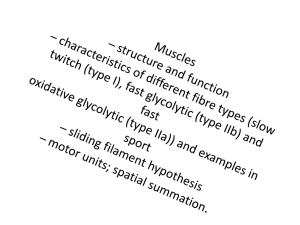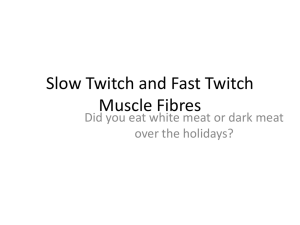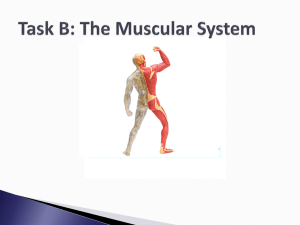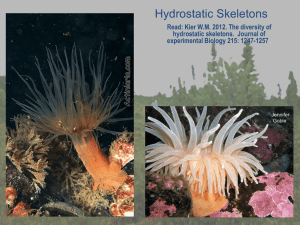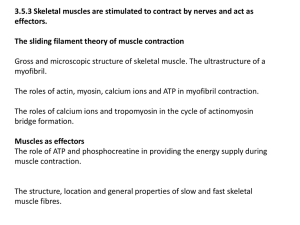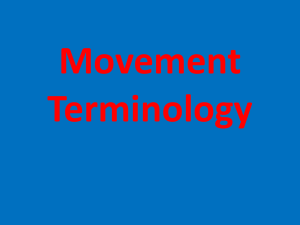Muscle Fibre Types
advertisement
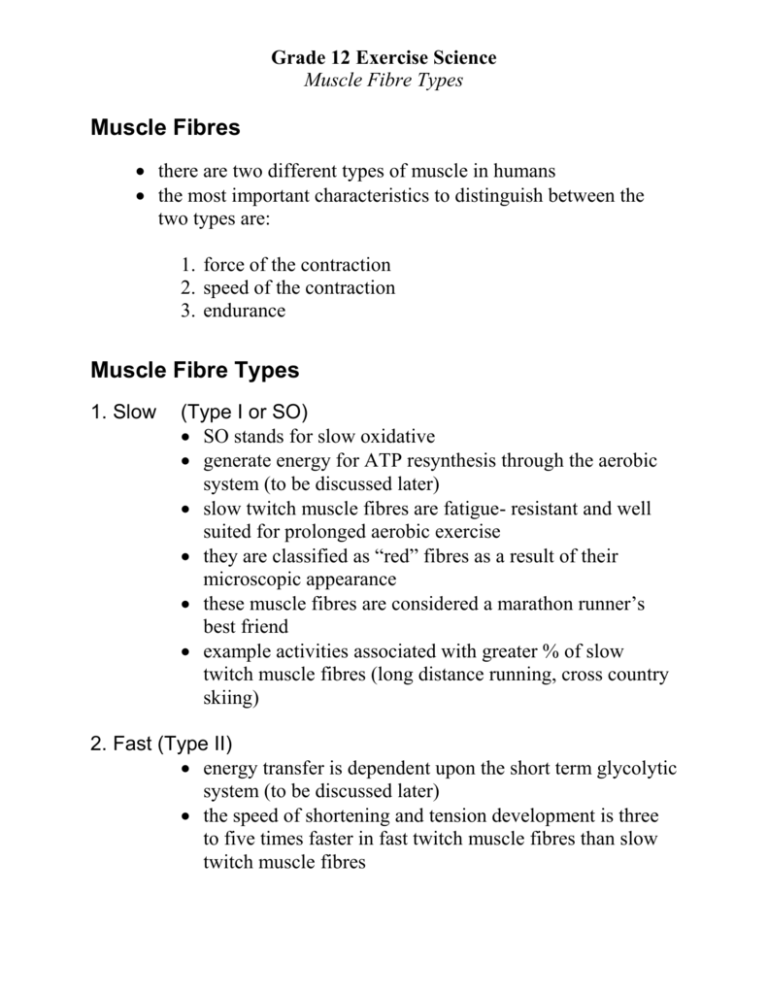
Grade 12 Exercise Science Muscle Fibre Types Muscle Fibres there are two different types of muscle in humans the most important characteristics to distinguish between the two types are: 1. force of the contraction 2. speed of the contraction 3. endurance Muscle Fibre Types 1. Slow (Type I or SO) SO stands for slow oxidative generate energy for ATP resynthesis through the aerobic system (to be discussed later) slow twitch muscle fibres are fatigue- resistant and well suited for prolonged aerobic exercise they are classified as “red” fibres as a result of their microscopic appearance these muscle fibres are considered a marathon runner’s best friend example activities associated with greater % of slow twitch muscle fibres (long distance running, cross country skiing) 2. Fast (Type II) energy transfer is dependent upon the short term glycolytic system (to be discussed later) the speed of shortening and tension development is three to five times faster in fast twitch muscle fibres than slow twitch muscle fibres Grade 12 Exercise Science Muscle Fibre Types these fibres are activated in short term sprint activities as well as in other forceful muscle actions that depend almost entirely on anaerobic metabolism for energy activation of fast twitch muscle fibres is also important in stop-and-go or change of pace sports such as basketball, soccer, lacrosse, or field hockey these sports require rapid energy that is only supplied by the anaerobic metabolic pathways fast twitch muscle fibres are actually subdivided into three categories A. Fast-oxidative-glycolytic (FOG) or Type IIa considered intermediate because of its fast shortening speed combined with a moderately well-developed capacity for both aerobic and anaerobic energy transfer example activities of FOG fibres include hockey, rugby, soccer, basketball, gymnastics (floor, bars, beam, rings), figure skating, wrestling, synchro B. Fast-glycolytic (FG) or Type IIb possesses the greatest anaerobic potential is the quickest to fatigue considered the sprinter’s best friend high intensity, powerful burst of speed/ strength example activities with a great % of type IIb fibres include sprints in track, swimming, throwing/ jumping events in track and field, vault in gymnastics Grade 12 Exercise Science Muscle Fibre Types Does everyone have all three kinds of muscle fibre? all three muscle fibre types can be seen in the body, but their percentages vary greatly from muscle to muscle for example, the gastrocnemius is almost all type II, while the soleus is almost entirely all type I most of our muscles contain a mix of all three fibre types % of each fibre type appears to be genetically fixed training has a small or negligible effect on fibre composition therefore, if born with deltoids and triceps that are largely type II fibres, you have a much greater potential in events like the shot put than if those muscles were largely type I if your quads and hamstrings are largely type I fibres, you would be best suited for long distance running Fatigue local muscular fatigue following short term, high intensity exercise is most likely caused by lactic acid accumulation in the blood and muscles lactic acid build up is not the reason for fatigue in endurance activities rather, fatigue is caused by depletion of muscle and liver glycogen, low blood glucose, loss of body water and electrolytes (salt, potassium), high body temperature, and boredom Speed of contraction of fast twitch (FT) and slow twitch (ST) units time required for FT fibres to generate maximal tension is about one third that required by ST fibres one reason for the faster contraction time in FT units is their greater anaerobic capacity Grade 12 Exercise Science Muscle Fibre Types another reason is the size of the motor neuron (motor nerve) that innervates the FT unit the motor unit consists of a motor nerve and all the muscle fibres it innervates motor neuron which innervates the FT unit is larger than the neuron that innervates the ST unit and can therefore propagate nerve impulse more quickly the nerve impulse that causes the motor unit to contract is transmitted along the axon faster therefore, individuals with higher percentages of FT fibres should be able to contract their muscles faster Force of contraction of FT and ST units force of contraction (tension) in FT units is much greater than that in ST units greater force is related to size of the individual fibres and to the number of fibres making up the motor unit both size and number of fibres are greater in FT units therefore, individuals with higher percentages of FT motor units are able to exert greater muscle forces Muscle Fibre Recruitment the brain estimates the number and type of fibres it needs for a task, then recruits them in an all or none fashion if these fibres are not enough, brain will do one of the following: 1. stimulate the already “on” fibres more rapidly (frequency) 2. ask for more of same fibres to join in (recruitment) 3. ask for fibres of a more powerful type to join in (recruit) Grade 12 Exercise Science Muscle Fibre Types recruitment order is based upon increase in size of motor neurons i.e. small motor neurons (type I) are recruited first and largest (type IIb) are recruited last for low intensity muscular work, small type I fibres will suffice once type I fibres become insufficient for the task, the brain will recruit larger muscle fibres when type IIb fibres are recruited, all fibre types are working therefore, power and speed movements utilise all fibre types, but are most dependant on type IIb fibres type I fibres may move a limb at extreme speeds if load is light; as load increases type IIa and IIb are called on evidence suggests that the most effective way to train human muscle is to work it at great intensity and slow speed; optimal strength training may require as little as one set of 8-12 reps taken to momentary muscular failure in humans, it is intensity or force requirements that determine which and how many muscle fibres will be used in other words, the brain recruits muscle based on how much force the muscle must create, not how fast it must contract ST or type I fibres are capable of moving limbs at extreme velocities if force requirements are low however, training rapidly but with low intensity cannot prepare muscle for high intensity athletic performance Grade 12 Exercise Science Muscle Fibre Types Comparison of FT and ST fibres Characteristic FT (Type II) ST (Type I) Speed of contraction high low Force of contraction (power) Time to fatigue high low quick long Fuel carbohydrates (glycogen) stored in muscle no carbohydrate and fats delivered via blood yes lactic acid heat carbon dioxide water heat Oxygen used Wastes
